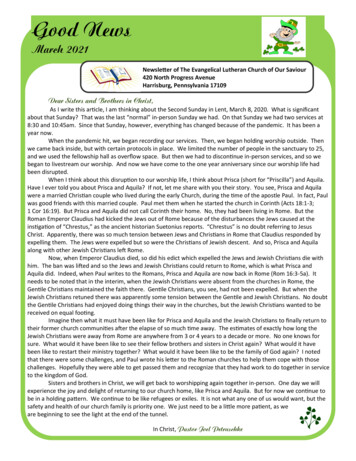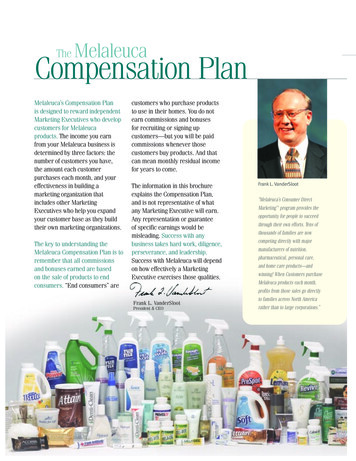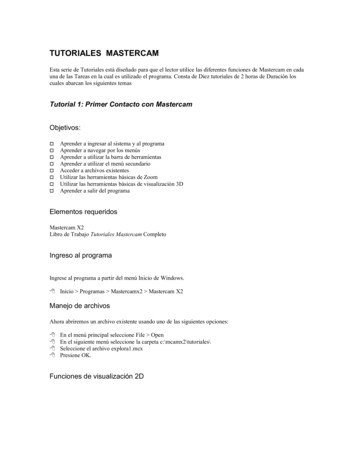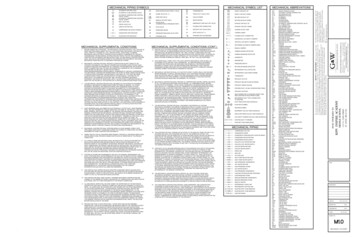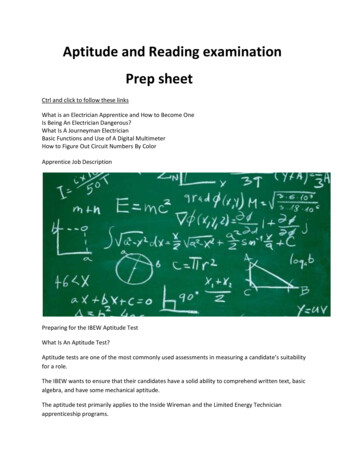
Transcription
MEC HANIC AL &SP A TIAL APTITUDE
MEC HANIC AL &SP A TIAL APTITUDENew York
Copyright 2001 LearningExpress, LLC.All rights reserved under International and Pan-American Copyright Conventions.Published in the United States by LearningExpress, LLC, New York.Library of Congress Cataloging-in-Publication Data:Mechanical and spatial aptitude.p. cm.—(Skill builders series)ISBN 1-57685-357-81. Mechanical Ability—Examinations, questions, etc. 2. Space perception—Examinations, questions, etc. 3. Reasoning (Psychology)—Examinations,questions, etc. I. LearningExpress (Organization) II. Skill builders series(New York, N.Y.)BF433.M4 M44 2001153.9'462—dc212001016501Printed in the United States of America987654321First EditionISBN 1-57685-357-8For Further InformationFor information or to place an order, contact LearningExpress at:900 BroadwaySuite 604New York, NY 10003Or visit our website at:www.learnatest.com
CONTENTS1 GETTING READY FOR A MECHANICAL/SPATIAL APTITUDE TEST2 THE LEARNINGEXPRESS TEST PREPARATION SYSTEM3 MECHANICAL APTITUDEShop ArithmeticTool KnowledgeMechanical InsightMechanical Knowledge4 SPATIAL CONCEPTSHidden FiguresBlock CountingRotated BlocksMatching Pieces and PartsSpatial AnalysisUnderstanding PatternsEye–hand CoordinationReading Maps5 INTERPRETING SYMBOLSSymbol SeriesSymbol AnalogiesSorting and Classifying FiguresSeries Reasoning Test6 DIAGNOSTIC TEST—PRACTICE WHAT YOU HAVE LEARNEDPractice Questions
C H A P T E RGETTING READY FOR AMECHANICAL/SPATIALAPTITUDE TEST1CHAPTER SUMMARYIf you’re the kind of person who has always been fascinatedwith gears and pulleys, nuts and bolts, and electrical mazes,this book is for you! In fact, you are probably the same person who can think in 3D and can use your natural mechanical/spatial abilities for your career. Chances are yourabilities will put you in a good position to take any kind ofexam that tests mechanical/spatial aptitude. Rememberthough, that practice makes perfect in the long run. That’swhy you’re reading this book.The ability to understand and use mechanical devices is critical fora job in many fields. Whether you decide to enter the military, applyfor a government job, or take a job in private industry, you’ll haveto take an entrance test that determines your skills and abilities. The military requires that all candidates take the ASVAB (Armed Services Vocational Aptitude Battery) test. Many government positions (local, state, andfederal) require you to take an entrance level exam that measures your skills.If you want to be a police officer or firefighter, your ability to use mechanical devices and solve spatial concepts problems is very important and showsup on most every test.People who work in the professions that require mechanical/spatialability use many different mechanical devices every day. Simple hand toolsLearningExpress Mechanical & Spatial Aptitude CHAPTER 11
–GETTING READY FOR A MECHANICAL/SPATIAL APTITUDE TEST–such as axes and wrenches, as well as more complex systems such as pumps and internal combustion enginesare standard tools of the trade. Spatial concepts go handin-hand with mechanical ability.If the exam you have to take includes a section onmechanical aptitude, it may cover topics with which youare very familiar, as well as some that are new. If theexam covers spatial aptitude, you’ll get lots of practicesolving that kind of problem as well.In this introductory chapter, you’ll find a fewsample questions to try. Next, you’ll be given many practice questions designed to improve your mechanical,spatial, and symbol reasoning abilities. Last, you can takea diagnostic test to practice what you have learned.Regardless of your background, understanding theconcepts in this book will benefit you on an examdesigned to test your mechanical/spatial abilities.WHAT IS MECHANICAL ABILITY?Basically, mechanical ability means that you can understand mechanical principles, devices, and tools, and theeveryday physics that make them work. You also havethe ability to reason and understand the direction ofmovement of gears in a system of gears. In addition, youcan see the patterns of moving parts in engines andmachines.Mechanical devices are an integral part of everyday life. When you imagine the numbers of cars on thehighways, offices with machines and computers thatmake routine office duties easier, and the recreationalvehicles used for vacations, you can quickly calculatethat a person with mechanical abilities will have lots ofwork to do in a lifetime.Mechanical aptitude questions tend to cover awide range of topics. The questions will usually be multiple choice with four or five possible answers. Some2questions may require previous knowledge of the topicwhile other questions will include all of the information you need to choose an answer.A typical mechanical aptitude question will looksomething like this:Which of the following is a common component of aninternal combustion engine?a. a pistonb. a compassc. a hammerd. a hydraulic jackThe answer is a, a piston. A compass is used todetermine a direction on a map. A hammer is used todrive nails. A hydraulic jack is used to lift heavy items.Some exams may test your knowledge of varioussystems or combinations of mechanical devices. Acommon example of a mechanical system is the internal combustion engine of an automobile. Other questions will require the identification of variousmechanical tools or devices like hand tools, gears, pulleys, levers, fasteners, springs, valves, gauges, and pumps.WHAT IS A MECHANICAL DEVICE?A mechanical device is a tool invented to make a giventask easier. For example, you could drive a nail into apiece of wood with a rock. However, a long time ago,a woodworker must have decided that there had to bea better way. A long slender handle with a hard pieceof metal for striking the nail provided more accuracyand did not damage the wood as easily. Thus was bornthe hammer.CHAPTER 1 LearningExpress Mechanical & Spatial Aptitude
–GETTING READY FOR A MECHANICAL/SPATIAL APTITUDE TEST–Most mechanical devices were invented in thesame manner—people looking for easier ways to perform their everyday jobs. Some mechanical devices—the lever, the wheel, and many hand tools—arethousands of years old. Other more complex devices,such as pumps and valves, were invented more recently.Many times the idea of a new mechanical device existsbut the technology to design it does not. For example,many years before the pump was invented, peopleprobably discussed the need for an easier way to movewater from the river to the town on the hill. However,the technologies of the electric motor and casting ofmetal had not yet been invented, so the modern pumpcould not possibly have been invented at that time.Mechanical devices cover a wide range and variety of tools. In general, mechanical devices are tools thatrelate to physical work and are governed by mechanical forces and movements.You can usually see what theydo and how they work—as opposed to, say, a light switchor a battery, which are electrical devices. Some tools areused to directly accomplish a specific task, such aswhen you use a handsaw to cut a piece of wood. Others, such as pulleys and gears may be used indirectly toaccomplish certain tasks that would be possible without the device but are easier with the device. Still others, such as gauges, only provide feedback informationon the operation of other mechanical devices. In yourdaily life, you see and use mechanical devices manytimes each day, so there’s no reason to be intimidatedby a mechanical aptitude section on any exam.COMMONLY TESTEDMECHANICAL DEVICESHAND TOOLStypes of hand tools including carpentry tools and automotive hand tools as well as hand tools specific to different trades. Since it is impossible to cover everyconceivable kind of hand tool, this chapter lists anddefines some of the hand tools used in everyday situations—and the ones you are most likely to be testedon.Some of the hand tools used by carpenters andother workers are listed on the table on the followingpage.Some of the hand tools used in the automotiveindustry are listed below.Wrenches are used to tighten and loosennuts and bolts. Examples include open endand box end wrenches, crescent, and pipewrenches. Mechanical jacks are used to lift cars so thattires can be changed. The jack in the trunk ofyour car is an example. Pliers are small pincers with long jaws forholding small objects or for bending and cutting wire. Examples are cutting pliers, electrical pliers, and long-nosed pliers. In addition,vice grips are considered locking pliers. Screwdrivers are tools used for loosening,tightening, or turning screws. Examples arePhillips and straight blade screwdrivers. Sockets and ratchets are used like wrenchesto loosen, remove, or tighten nuts and bolts;there are many different sizes. Torque wrenches are used to measure thetightness, i.e., the proper torque, of a nut orbolt. Gear pullers are used to remove gears andpulleys. Hand tools are defined as tools operated not by motorsbut rather by human power. There are many differentLearningExpress Mechanical & Spatial Aptitude CHAPTER 13
–GETTING READY FOR A MECHANICAL/SPATIAL APTITUDE TEST–HAND TOOLSToolDescription/FunctionExampleshammerused primarily to drive and remove nails, as well as toclaw hammer, rubberpound on devices such as chiselsmallet, ball-peen hammerthin metal blade with a sharp-toothed edge used to cuthandsaw, hacksaw,wood or metaljigsawused to tighten and loosen screws and boltsslotted (regular) head,sawscrewdriverPhillips headleveltwo- to four-foot long piece of metal or plastic thathand level, laser levelcontains calibrated air bubble tubes, used to ensurethat things are vertically plumb or horizontally levelsquareused primarily to aid in drawing a cut line on a boardL-square, T-squareto insure a straight, ninety-degree cutplanemetal tool with a handle and an adjustable blade, usedblock plane, various sizesto shave off thin strips of wood for the purpose ofof carpenter’s planessmoothing or levelingchiselprotractorC-clampcompassmetal tool with a sharp, beveled edge that is struckscoop chisel, beveledwith a hammer in order to cut and shape stone, metal,chisel, masonry chisel,or woodcold chiselhalf-circle with tick marks around the edge spaced atonly one type, made ofone-degree intervals, used to measure anglesmetal or plasticC-shaped metallic instrument with a threaded stop thatfurniture clamps, manycan be adjusted to clamp together pieces of material oftypes and sizes of metallicdifferent thicknessesC-clampsV-shaped metallic instrument with a sharp point on theonly one type existsend of one leg and a pencil or pen on the end of theother leg, used to draw circlesGEARSA gear is generally a toothed wheel or cylinder thatmeshes with another toothed element to transmitmotion or to change speed or direction. Gears are typically attached to a rotating shaft turned by an outsideenergy source such as an electric motor or an internal4combustion engine. Gears are used in many mechanical devices including automotive transmissions, bicycles, and carnival rides such as Ferris wheels andmerry-go-rounds.Gears can be used in several different configurations. Two gears may be connected by directly touch-CHAPTER 1 LearningExpress Mechanical & Spatial Aptitude
–GETTING READY FOR A MECHANICAL/SPATIAL APTITUDE TEST–ing each other as in an automotive transmission. In thisarrangement, one gear spins clockwise and the otherrotates counter-clockwise. Another possible configuration is to have two gears connected by a loop of chainas on a bicycle. In this arrangement, the first gearrotates in one direction causing the chain to move. Sincethe chain is directly connected to the second gear, thesecond gear will immediately begin to rotate in the samedirection as the first gear.Many times a system will use two gears of different sizes as on a ten-speed bicycle. This will allowchanges in speed of the bicycle or machine.Problems about gears will always involve rotationor spinning. The easiest way to approach test questionsthat involve gears is to draw a diagram of what the question is describing. Use arrows next to each gear toindicate which direction (clockwise or counter-clockwise) it is rotating.PULLEYSA pulley consists of a wheel with a grooved rim in whicha pulled rope or cable is run. Pulleys are commonly usedwith ropes or steel cables to change the direction of apulling force.Pulleys are often used to lift things. For instance,a pulley could be attached to the ceiling of a room. Arope could be run from the floor, up through the pulley and back down to a box sitting on the floor. The pulley would allow you to pull down on the rope and causethe box to go up. That is, the pulley caused a change indirection of the pulling force. This is the principlebehind the elevator.Another common use for a pulley is to connectan electric motor to a mechanical device such as a pump.One pulley is placed on the shaft of the motor, and asecond pulley is placed on the shaft of the pump. A beltis used to connect the two pulleys. When the motor isturned on, the first pulley rotates and causes the beltto rotate. That in turn causes the second pulley torotate and turn the pump. This arrangement is very similar to the previous example of a bicycle chain and gears.You may have seen pulleys used in a warehouseto lift heavy loads or on construction sites on cranes.The cable on a crane extends from the object being liftedup to the top of the crane boom, across a pulley andback down to the electric winch that is used to pull onthe cable. In this situation the pulley again causes achange in direction of the pulling force from the downward force of the winch that pulls the cable to theupward movement of the object being lifted.LEVERSA lever is a very old mechanical device. A lever typicallyconsists of a metal or wooden bar that pivots on a fixedpoint. The object of using a lever is to gain a mechanical a
6 DIAGNOSTIC TEST—PRACTICE WHAT YOU HAVE LEARNED Practice Questions CONTENTS. LearningExpress Mechanical & Spatial Aptitude CHAPTER 1 1 C H A P T E R CHAPTER SUMMARY If you’re the kind of person who has always been fascinated with gears and pulleys, nuts and bolts, and electrical mazes, this book is for you! In fact, you are probably the same per-son who can .

